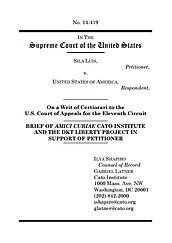Luis v. United States
Learn more about Cato’s Amicus Briefs Program.
Criminal asset forfeiture has the taste of Old Testament justice: an eye for an eye, a tooth for a tooth. The bank robber stole $100,000, so the government takes $100,000 from him. That seems right and fair, but only if we know that the defendant’s guilty. If the government took $100,000 from someone who was innocent, or whose guilt was ambiguous, it wouldn’t be an “unjust” forfeiture, it would be theft—or, to be more politic, an uncompensated and unwarranted taking. Consider the case of Sila Luis. For several years, Luis ran a healthcare company that provided home nursing services to patients enrolled in Medicare. In 2012, the government accused Luis of fraud, claiming that her company billed Medicare for unnecessary services. In addition to criminal charges, the grand jury indictment included a forfeiture finding, stipulating that if Luis is convicted, up to $45 million of her personal assets would be forfeited, to make up for all of the money her company ever received from Medicare. Leaving aside the validity of that number—the government hasn’t alleged that all, or even most, of the claims submitted to Medicare were false—the questionable fairness of holding an individual personally responsible for a company’s liabilities, and the fact the Luis doesn’t have anywhere near $45 million, the indictment got one thing right: the government should only be able to confiscate Luis’s property after she’s been convicted. Of course, the government found a loophole: a statute providing that when the government thinks a defendant is going to spend or hide assets before they can be forfeited, prosecutors can ask for a court order “freezing” the assets. Freezing property is practically the same as confiscating it; the defendant technically remains the owner, but is no longer allowed to sell or even use the property. The government applied for such an order on the same day that Luis was indicted—and three years later, it’s still in effect. Because Luis’s net worth is only a fraction of the $45 million the government claims, the freezing order applies to all of her assets. As a result, Luis can’t afford to pay a lawyer to defend her at trial. Last year in Kaley (another case where Cato filed a brief), the Supreme Court ruled that there is no Sixth Amendment right to hire counsel with “tainted” money (and even the process due is less before freezing); the robber can’t use the money he stole from the bank to pay his lawyer, because he never actually owned it in the first place. But Luis is arguing that Kaley doesn’t apply to cases like this, where the government admits that none of the frozen property is in any way connected to illegal activity (only that it may be necessary to satisfy an eventual judgment). While Cato agrees with Luis’s Sixth Amendment argument, we’ve filed an amicus brief, joined by the DKT Liberty Project, challenging the legitimacy of freezing orders on an institutional level. Fifteen years ago, the Supreme Court stopped federal courts from freezing a defendant’s assets where the plaintiff is afraid that the defendant will become bankrupt because the whole point of a trial is to determine what, if anything, the defendant owes. The Court has been adamant that unless and until the plaintiff wins that trial, judges should not interfere with the defendant’s existing rights—unless a court order is the only way to prevent a significant and incurable injury to the plaintiff that substantially outweighs any harm this action would do to the defendant. The freezing order here isn’t protecting the government from any new loss, while the burden it continues to impose on Luis is grievous, especially since she still faces criminal charges. The Supreme Court was right when it condemned freezing orders as “nuclear weapons.” They are powerful and destructive—and their use is rarely if ever justified.
